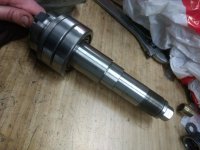Luke Rickert
Hot Rolled
- Joined
- Oct 24, 2007
- Location
- OSLO
Hi all, I pulled the vertical head off my 13 to test out my newly rebored high speed head. Anyway having it on the bench I figured I would do some investigation as I have been getting some noise, particularly the top of it when pushed hard. Judging from the original type black thread lock, old looking grease and the noise I am guessing it was not subjected to the specified cleaning and relubrication every 5 years of use.
The manual section and diagram are here: Schaublin13_vertical_head.pdf - Google Drive
(I don't think this info is found elsewhere online, I have the original manual for this machine)
My german isn't amazing but I think it says that once I have the tensioning nut off (13.10.208) a light hit with a "fiber hamer" should remove the bearing assembly.
I am guessing I may need to replace at least the upper bearing but I would like to remove, and clean them first to be sure as P4 (ABEC 7) bearings aren't exactly cheap.
For reassembly it says
"Die Kugellager der Vertikalspindel erfordern eine Vorspannung. Bei ausgebauter Spindle werden sie vorerst durch Abstimmen des Distanzringes (13-10.215) spielfrei eingestellt.
Um die gewünschte Vorspannung der Lager zu erhalten wird dieser Ring anschliessend noch um 1/100 mm gekürzt"
I think means that to to get the correct tension the spacer ring (which is under the top bearing) needs to be shortened by 0,01mm after there is no play. This I assume will be more clear when I get the whole thing apart. I am guessing this preload should be easy enough to calculate from the pitch of the tension nut. (I think it is something very fine, around 1mm pitch) so so 3,6 degrees of rotation to the nut which isn't so very much.
Can anyone add to this?
thanks


The manual section and diagram are here: Schaublin13_vertical_head.pdf - Google Drive
(I don't think this info is found elsewhere online, I have the original manual for this machine)
My german isn't amazing but I think it says that once I have the tensioning nut off (13.10.208) a light hit with a "fiber hamer" should remove the bearing assembly.
I am guessing I may need to replace at least the upper bearing but I would like to remove, and clean them first to be sure as P4 (ABEC 7) bearings aren't exactly cheap.
For reassembly it says
"Die Kugellager der Vertikalspindel erfordern eine Vorspannung. Bei ausgebauter Spindle werden sie vorerst durch Abstimmen des Distanzringes (13-10.215) spielfrei eingestellt.
Um die gewünschte Vorspannung der Lager zu erhalten wird dieser Ring anschliessend noch um 1/100 mm gekürzt"
I think means that to to get the correct tension the spacer ring (which is under the top bearing) needs to be shortened by 0,01mm after there is no play. This I assume will be more clear when I get the whole thing apart. I am guessing this preload should be easy enough to calculate from the pitch of the tension nut. (I think it is something very fine, around 1mm pitch) so so 3,6 degrees of rotation to the nut which isn't so very much.
Can anyone add to this?
thanks







